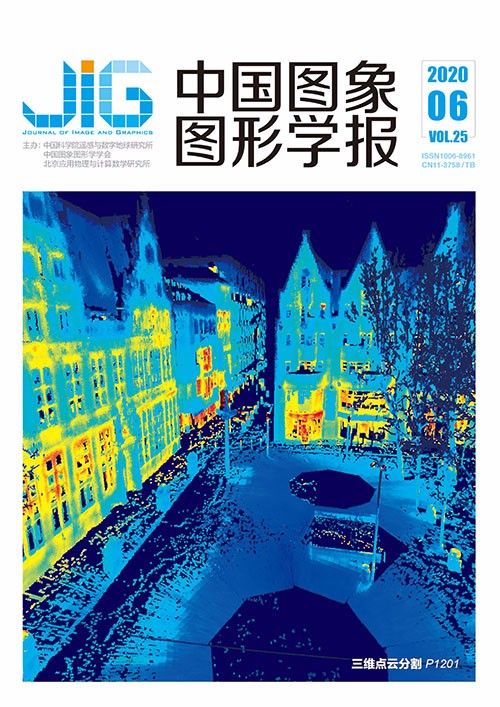
双层水平集描述眼底图像视杯视盘分割
摘 要
目的 青光眼是一种可导致视力严重减弱甚至失明的高发眼部疾病。在眼底图像中,视杯和视盘的检测是青光眼临床诊断的重要步骤之一。然而,眼底图像普遍是灰度不均匀的,眼底结构复杂,不同结构之间的灰度重叠较多,受到血管和病变的干扰较为严重。这些都给视盘与视杯的分割带来很大挑战。因此,为了更准确地提取眼底图像中的视杯和视盘区域,提出一种基于双层水平集描述的眼底图像视杯视盘分割方法。方法 通过水平集函数的不同层级分别表示视杯轮廓和视盘轮廓,依据视杯与视盘间的位置关系建立距离约束,应用图像的局部信息驱动活动轮廓演化,克服图像的灰度不均匀性。根据视杯与视盘的几何形状特征,引入视杯与视盘形状的先验信息约束活动轮廓的演化,从而实现视杯与视盘的准确分割。结果 本文使用印度Aravind眼科医院提供的具有视杯和视盘真实轮廓注释的CDRISHTI-GS1数据集对本文方法进行实验验证。该数据集主要用来验证视杯及视盘分割方法的鲁棒性和有效性。本文方法在数据集上对视杯和视盘区域进行分割,取得了67.52%的视杯平均重叠率,81.04%的视盘平均重叠率,0.719的视杯F1分数和0.845的视盘F1分数,结果优于基于COSFIRE(combination of shifted filter responses)滤波模型的视杯视盘分割方法、基于先验形状约束的多相Chan-Vese(C-V)模型和基于聚类融合的水平集方法。结论 实验结果表明,本文方法能够有效克服眼底图像灰度不均匀、血管及病变区域的干扰等影响,更为准确地提取视杯与视盘区域。
关键词
Segmentation of optic cup and disc based on two-layer level set describer in retinal fundus images
Wang Ying1, Yu Xiaosheng2, Chi Jianning2, Lei Xiaoliang1, Wu Chengdong2(1.College of Information Science and Engineering, Northeastern University, Shenyang 110819, China;2.Faculty of Robot Science and Engineering, Northeastern University, Shenyang 110819, China) Abstract
Objective Glaucoma is one of the most common eye diseases it can lead to severe vision loss and even permanent blindness. Glaucoma is the primary cause of irreversible blindness worldwide. Diagnosing the disease in its early stage is significant for decreasing the mental and financial pressures of patients. The diagnosis of glaucoma using retinal fundus images is achieved by calculating cup to disc ratio (CDR). The optic disc (OD) is a central yellowish region in retinal fundus images. The optic cup (OC) is the bright central part of the OD that presents variable sizes. Any changes in the shapes of OD and OC may indicate glaucoma. A high CDR value shows that the eye is suffering from glaucoma to a large extent. Therefore, the detection of OC and OD in fundus images is an important step in the clinical diagnosis of glaucoma. The accurate segmentation of OC and OD is facing serious challenges, including severe intensity inhomogeneity, complex fundus image structure, grayscale overlap between different structures, and interference with blood vessels and lesions. Therefore, to accurately segment the OC and OD regions in fundus images, we present a novel OC and OD segmentation method based on a two-layer level set describer in this study. This approach can simultaneously extract the boundaries of OD and OC. Method Our proposed method consists of four steps. First, OC and OD contours are represented by two different layers of a one-level set function by constructing a two-layer level set model. Fundus images are typically inhomogeneous in gray levels. OC and OD regions exhibit different brightness characteristics compared with the background region in retinal fundus images. Therefore, the local intensity information of an image is used as data term to derive the evolution of the active contours and overcome intensity inhomogeneity in fundus images. Second, the distance constraint is established on the basis of the position relationship between OC and OD. The contours of OC and OD in fundus images are approximately two ellipse shapes. OC is located inside OD, and the distance between OC and OD varies smoothly. The distance constraint term is introduced to restrain the distance between the two-level layers of the one-level set function. The major contribution of the distance constraint term is that the relationship between OC and OD contours in a one-level set function is simpler to establish compared with using multiphase level set methods. Third, considering the complex structure of fundus images, the interference of blood vessels and lesions leads to sharp changes in contours, considerably affecting the accuracy of segmentation results. Therefore, we use the prior information that OC and OD always approach an ellipse shape to guide the segmentation process. In accordance with the geometric characteristics of OC and OD, the shape prior information of OC and OD is introduced to constrain the evolution of the active contour and realize the accurate segmentation of OC and OD. Lastly, we build an integral energy function by integrating the aforementioned three terms. Meanwhile, the traditional length penalty term is also included in the final integral energy function. The final energy function consists of four parts: local intensity information, distance constraint, prior information, and traditional length penalty terms. The segmentation of OC and OD is achieved by minimizing the final integral energy function using the gradient descent method. When the convergence condition of the level set function is satisfied, we obtain the final optimized level set function. We acquire OC and OD contours that correspond to the 0- and k-layers of the optimized level set function. Result The proposed method is validated using the CDRISHTI-GS1 dataset provided by the Aravind Eye Hospital of India with a true outline annotation of OC and OD. The dataset consists of 101 color retinal fundus images; each of which has a field of view of 30° and a resolution of 2 896×1 944 pixels. This dataset is primarily used to verify the robustness and effectiveness of OC and OD segmentation methods. The method proposed in this study achieves 81.04% of the average OD overlap rate, 67.52% of the average OC overlap rate, 0.719 of the OC F1-score, and 0.845 of the OD F1-score on the CDRISHTI-GS1 dataset. The method outperforms the OC and OD segmentation method based on the combination of shifted filter responses filter model, the shape prior constraint-based multiphase Chan-Vese model, and the cluster fusion-based level set method. We also show the visual results of the experimental process. The bias field and bias-corrected image are displayed to illustrate how the proposed method overcomes intensity inhomogeneity in fundus images. The histograms of the original image and the bias-corrected images are provided to present an intuitive result of the corrected image intensity. Conclusion This method successfully performs the segmentation of OC and OD regions by representing OC and OD contours with different level layers of a one-level set function. The intensity inhomogeneity of fundus images is effectively processed using the local information data term. The distance constraint term achieves a smooth change in distance between OC and OD contours. The ellipse shape prior constraint overcomes the blood vessels and lesions in fundus images, and the final segmented OC and OD contours are approximately two ellipse shapes. The experimental results show that the proposed method can simultaneously and accurately segment OC and OD regions. Moreover, it exhibits superior performance over other methods.
Keywords
retinal fundus images two-layer level set method optic cup segmentation optic disc segmentation shape prior constraint
|



 中国图象图形学报 │ 京ICP备05080539号-4 │ 本系统由
中国图象图形学报 │ 京ICP备05080539号-4 │ 本系统由